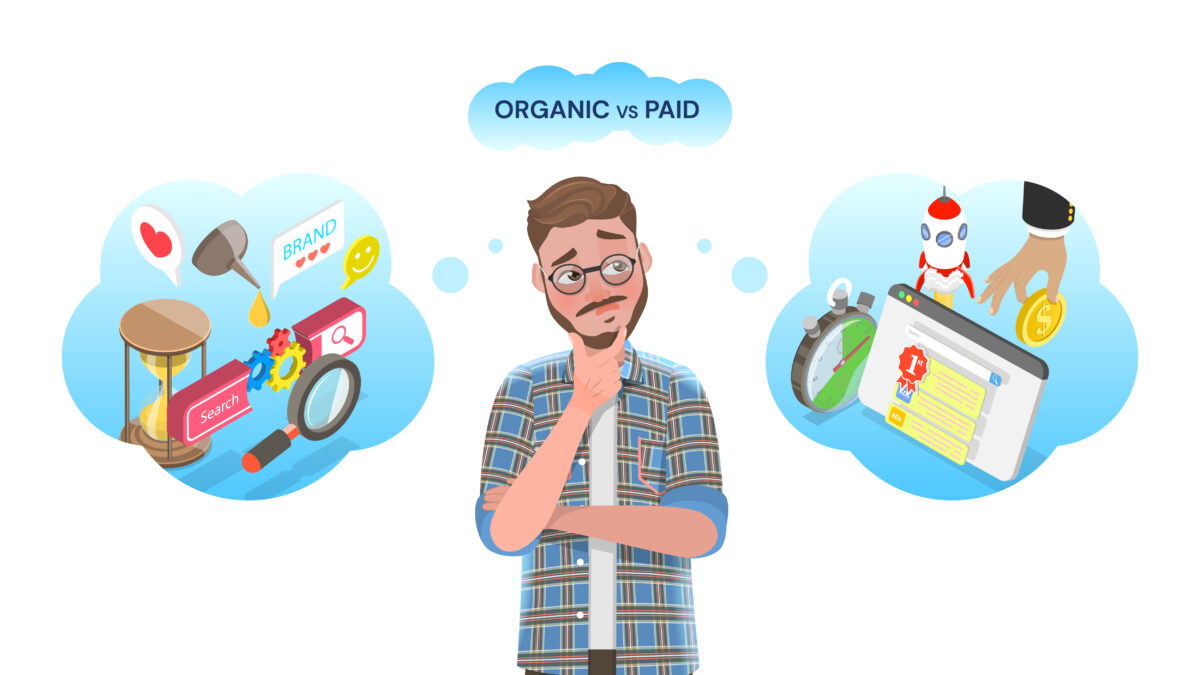
Organic vs. Paid Traffic: Striking the Right Balance for Non-Profit Organizations
With a target audience that is increasingly reachable through digital marketing channels over traditional, non-profit organizations can no longer avoid these platforms. Driving traffic to their website is a key metric for many NGOs.
The importance of traffic—both organic and paid— cannot be overstated. Traffic is the lifeblood of your online presence. It’s how you attract new supporters, raise awareness for your cause, and ultimately, secure donations.
But do you opt for organic or paid traffic? And how do you strike the right balance between the two?
Organic vs. Paid Traffic
First, let’s explore each of these traffic sources.
Organic traffic refers to visitors who land on your website as a result of unpaid search results. They found your website after using a search engine like Google or Bing, hence the term “organic”. This type of traffic is often seen as more valuable because it’s free and tends to bring in users who are genuinely interested in your content or services. For example, if someone types “best non-profit organizations in Ottawa” into Google and your organization’s website comes up in the search results, the visit is considered organic traffic.
Paid traffic, on the other hand, is traffic you get from paid advertising efforts. This can include pay-per-click (PPC) campaigns, social media ads, display ads, and more. While it requires an upfront investment, paid traffic can be highly targeted and can drive quick results.
Understanding Organic Traffic
Benefits and Disadvantages of Organic Traffic for Non-Profits
There are numerous benefits to organic traffic for non-profits.
- Cost-effectiveness: Unlike paid advertising, you don’t have to spend money to generate organic traffic.
- Attracts more qualified visitors: People who find your site organically are actively searching for the services or information you offer, making them more likely to engage with your content or donate to your cause.
However, there are also disadvantages to organic traffic. It takes time and effort to optimize your website for search engines and build a steady stream of organic traffic. Also, ranking high on search engine results can be competitive, especially for popular keywords related to your cause.
Techniques to Increase Organic Traffic
There are several techniques that non-profits can use to increase organic traffic:
- SEO (Search Engine Optimization): This involves improving your website’s visibility in search engines. It includes techniques such as keyword research, on-page optimization (using keywords in your content, meta tags, URL structure), and off-page optimization (building high-quality backlinks). Check out our recent article on SEO best practices (Part 1 and Part 2) to learn more.
- Content Marketing: Regularly publishing valuable, relevant content on channels your visitors spend time on attracts organic traffic. It helps establish your non-profit as an authority in your field and encourages visitors to share your content, further increasing your reach.
- Social Media: While social media traffic is not classified as organic traffic, it can significantly contribute to it. By sharing your content on social media platforms, you can reach a wider audience, drive traffic to your website, and improve your search engine rankings.
Remember, increasing organic traffic is a long-term strategy but it can yield significant benefits for your non-profit organization in terms of visibility, engagement, and fundraising.

Understanding Paid Traffic
Benefits and Disadvantages of Paid Traffic for Non-Profits
There are numerous benefits to driving traffic to your website through paid advertising:
- Targeted Reach: Paid traffic allows you to target specific demographics, locations, and interests, ensuring your message reaches the right audience.
- Immediate Results: Unlike organic tactics, which take time to show results, paid traffic can provide immediate visibility and results.
- Measurable: With analytics tools, you can track the performance of your ads and adjust your strategies accordingly, especially iterating for changes in goals such as looking to drive more awareness, donations, volunteers etc.
However, like with organic traffic, paid traffic also has some cons. It can be quite expensive, especially with non-profits that may be working within limited marketing and communications budgets. It can also be temporary in that interest and response may stop when the ads are stopped, without resulting in long-term results (such as the ones that SEO efforts provide). Lastly, it could also cause ad fatigue where, seeing the ads multiple times may lead to users simply ignoring them. This can reduce effectiveness over time.
Common Channels for Paid Traffic
The three most popular and common channels for paid traffic include:
- Google Ads: Non-profits can run text and image-based Pay-Per-Click campaigns, where they pay each time a user clicks on their ad in search results. NGOs and Non-Profits are also eligible for the Google Ad Grant in many countries, where they receive $10,000 per month to run PPC campaigns through Google Ads. (Check if you’re eligible for the Google Ad Grant here.)
- Social Media Ads: Platforms like Facebook, Instagram, LinkedIn, and Twitter offer various ad formats to reach their massive user bases. They allow targeted advertising that can reach your audiences when they’re receptive to the information you’re sharing.
- Sponsored Content: This could be an article, blog post, or video that’s promoted on another website or platform. It’s a way to provide valuable content while subtly promoting your non-profit.
By understanding the ins and outs of paid traffic, you can make informed decisions about where to allocate your marketing resources for maximum impact.
Practical Steps for Striking the Right Balance: Organic vs. Paid Traffic
Organizations, especially NGOs and non-profits, can no longer look at organic or paid traffic as an either/or. To reach your target audience effectively, it is essential to find the right balance between the two options, ensuring that it suits your unique goals. A balanced approach allows you to enjoy the best of both worlds – the credibility and long-term sustainability of organic traffic combined with the immediate, targeted impact of paid traffic.
Factors Influencing the Balance
- Budget: What does your budget look like? While organic traffic is free, it requires a significant time investment. Conversely, paid traffic requires a financial investment but results can be achieved more quickly.
- Target Audience: Who are you trying to reach? If your audience spends a lot of time on social media, for instance, investing in paid social media ads might make sense.
- Campaign Goals: Are you looking for quick results for a time-sensitive campaign? Paid traffic might be the way to go. If you’re aiming for long-term visibility and credibility, focusing on organic traffic would be beneficial.

Implementing an SEO Strategy for Organic Traffic
One of the most effective tactics to increase organic traffic is search engine optimization (SEO). Here are a few steps to get started:
- Keyword Research: Identify keywords relevant to your cause and use them in your website content. This helps search engines understand what your site is about and rank it accordingly.
- Quality Content: Regularly publish high-quality, relevant content. This helps with SEO and positions your organization as a thought leader in your sector.
- Optimize On-Page SEO: Pay attention to meta descriptions, title tags, and URL structures. These small details can significantly improve your site’s visibility.
For more information on mastering SEO, check out Part 1 and Part 2 of our article series on using SEO to boost your online presence.
Effectively Using Paid Advertising Channels
For paid traffic, you can explore channels like Google Ads, Facebook Ads, and sponsored content. Here are a few tips to keep in mind:
- Targeting: Use the targeting options these platforms offer to reach your specific audience.
- Ad Design: Make sure your ads are visually appealing and have a clear call-to-action.
- Test and Refine: Experiment with different ad formats, messaging, and targeting options. Monitor performance and tweak as necessary.
Tracking, Measuring, and Optimizing Your Traffic Sources for Maximum Impact
Driving traffic to your website is only the first step. You must also understand where that traffic is coming from (paid vs. organic, and which specific source of each), how it’s engaging with your content, and what actions it’s taking. By tracking, measuring, and optimizing your traffic sources, you can ensure you’re getting the most bang for your buck.
Tracking Your Traffic Sources
Tracking your traffic sources means identifying where your website visitors are coming from. Are they finding you through organic search? Social media? Directly typing in your URL? Or perhaps through your paid advertising efforts?
Google Analytics is a powerful tool that can help you track your traffic sources. By setting up UTM parameters — snippets of text added to the end of a URL — you can track the performance of your campaigns and identify which sources are driving the most traffic, conversions, and donations.
Measuring the Success of Your Traffic
Once you know where your traffic is coming from, the next step is to measure the success of these sources. This involves looking at key metrics such as:
- Bounce Rate: The percentage of visitors who leave your site after viewing only one page. A high bounce rate could indicate that your content isn’t resonating with your audience or that your site is difficult to navigate.
- Average Session Duration: How long, on average, do visitors stay on your site? The longer the session, the more engaged your visitors likely are.
- Conversion Rate: Perhaps the most important metric for non-profits, the conversion rate tells you what percentage of visitors are completing a desired action, such as making a donation, signing up for a newsletter, or registering for an event.
Optimizing Your Traffic for Maximum Impact
With a clear understanding of where your traffic is coming from and how it’s performing, you can now optimize your efforts for maximum impact. This might involve investing more in the channels that are driving the most conversions, tweaking your SEO strategy to improve your organic search rankings, or refining your paid ads to better target your ideal donors.
Optimization is an ongoing process. Regularly review your metrics, adjust your strategies, and strive for improvement to ensure your non-profit is effectively leveraging both organic and paid traffic to increase awareness, drive donations, and further your cause.
In conclusion, finding your non-profit’s unique balance between organic and paid traffic is essential. Organic traffic is crucial because it helps establish your credibility and authority, builds trust in your organization, and is sustainable over time. Paid traffic, while requiring a financial investment, allows you to reach a broader audience quickly, and target specific demographics to ensure your message reaches those most likely to engage with your cause.
The perfect blend differs for every organization and depends on various factors like goals, budget, industry, and competition. It’s about mitigating the weaknesses of each channel and capitalizing on their strengths. Both organic and paid traffic complement each other when synced effectively. The key lies in continuous experimentation, evaluation, and adjustment of your strategies to see what works best for your cause.
Ultimately, this balanced approach will help you reach and expand your audience, driving your non-profit towards its mission more effectively and efficiently.
Still not sure about the right mix of paid and organic for your goals?
Speak to a Marketing Specialist at Cyan Solutions today! Contact Us.

Discover what Cyan can do for you
We want to get to know you better so we can understand what services are going to help you meet your goals.